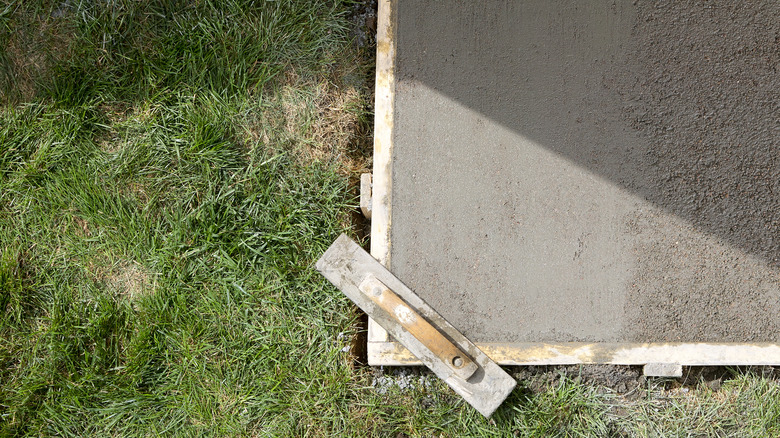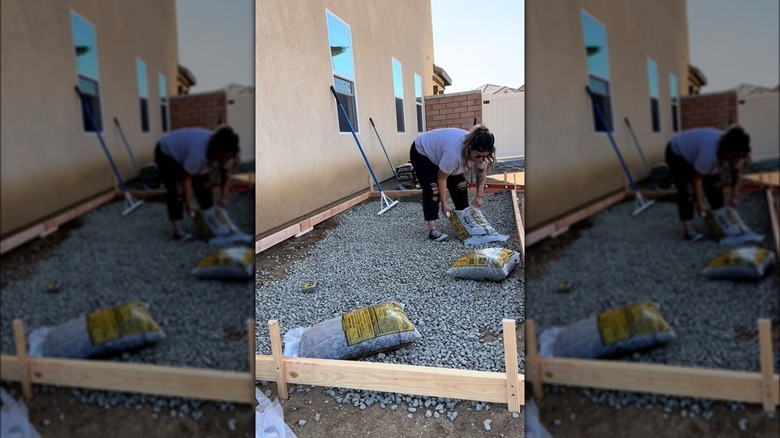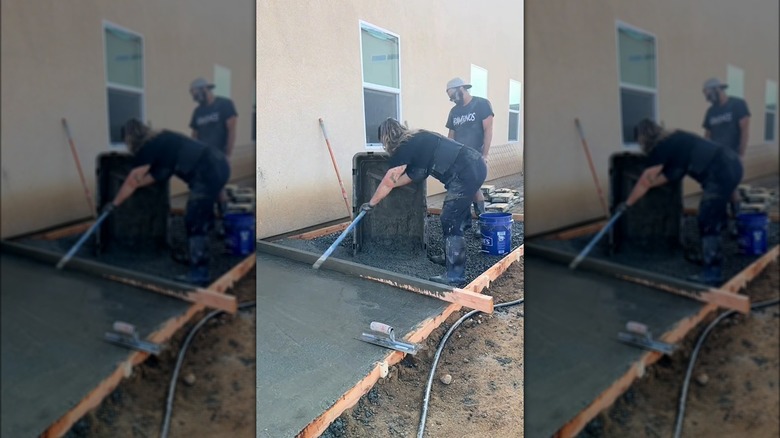DIY A Concrete Pad To Elevate Your Backyard Design And Entertainment Options
If you like the idea of creating a gathering place in your backyard, you've probably researched dozens of outdoor patio ideas to revamp the space. What you'll often notice when exploring options is that the patio space almost always has a firm surface before adding the furniture and other design elements. People rarely build entertainment spaces on grass, gravel, or bare dirt.
Adding a DIY concrete patio to your yard can provide a sturdy surface to create your dream gathering space. Even if you are a novice, this is a job you probably can handle. TikTok user @_the_minimalist_mama_ put together a video that shows how to save some money by doing a DIY job of pouring a concrete patio, even though this was their first time trying such a project.
Although the TikTok video did not specify the tools required for the job, pouring concrete in a pad like this typically involves a measuring tape, shovel, hammer, gravel, wood stakes, two-by-four lumber to go around the perimeter, wheelbarrow, level, string, tamper, float, pointing trowel, and hoe for mixing concrete. Most experts recommend that you dig down at least a few inches into the ground to make the base for the pad, but the TikTok video did not show any digging. Digging about 8 inches would allow the pad to be flush to the ground while digging about 4 inches is suitable when you want the slab raised a few inches above the ground.
Steps to build a DIY concrete pad for a patio
The first step is creating the base area for the concrete pad. If you have grass in the area, you would first have to remove it. However, the TikTok video was working from a dirt base, which simplified this step. The TikTok video then laid out the frame for the concrete pad, using the two-by-fours around the perimeter. The TikTok video did not specify the dimensions of the patio, but a typical patio measures up to one-third of the square footage of the main floor of the home. Screw the two-by-fours to wood stakes that you can pound into the ground to secure the perimeter. Use a level to be certain the two-by-fours are properly aligned.
Next, spread gravel throughout the space for the patio. The gravel layer should be close to 4 inches in thickness. Try to use driveway gravel with pieces 1 inch and smaller in size. The TikTok video shows spraying water over the gravel with a garden hose and then using a tamper to fully compact it.
Mix the concrete in the wheelbarrow then spread it over the top of the gravel to the top of the two-by-fours. A typical concrete pad for a patio should be 4 inches thick. The TikTok user flattened the concrete by dragging another two-by-four and used a float to create the smoothest possible surface. Use a pointing trowel to separate the concrete from the frame.
What other things should I know before trying to DIY a concrete patio pad?
This process will take a few hours at a minimum, depending in part on the size of the pad you are creating. The TikTok video from @_the_minimalist_mama_ says the job took five hours, but they were working in cooler weather which gave them extra time to work the concrete, as it sets more slowly in cooler weather than in hot weather. The TikTok video also mentioned that the work of pouring concrete is quite grueling, so you'll have to determine whether you can handle the physical demands.
The TikTok video did not provide a cost estimate for the project. Factors for estimating cost will be the size of the space and the number of tools you must buy. The typical range of costs to build a patio from scratch is $3,000 to $8,000, but your DIY project could be quite a bit less for a small pad. And, of course, you'll save money on labor for a DIY job versus hiring a pro.
Finally, because the TikTok video showed building the concrete pad directly against the home, be certain the concrete slab's configuration moves water away from the home. You'd want the pad to have a slight slant (about 1/4 inch for every linear foot of concrete) that moves rainwater away from the house to prevent water from pooling against the foundation, which could cause severe damage.


